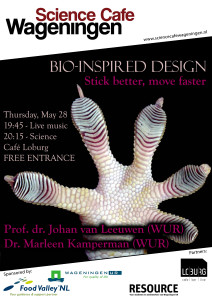Summary
Human ingenuity has allowed us to find solutions to complex problems for millennia, but some problems cannot be tackled using human ingenuity as a starting point. So how about using the solutions we see around us every day in a clever way? Flies walking on the ceiling without glue, fish swimming without propellers and us humans walking or running fluidly without wheels. We still do not understand many solutions evolution came up with and so far we have developed ‘easy’ alternatives: glue, propellers, wheels. But how can we tackle problems our conventional methods cannot solve, can we take the next step, inspired by the living world around us?
What can we learn from nature? And how? In this Science Café prof. dr. Johan van Leeuwen and dr. Marleen Kamperman shed a light on how we learn from the solutions nature has come up with to solve new and old problems. Both have focused their research on understanding solutions in the animal kingdom to eventually apply them in daily life.
Prof. dr. ir. Johan van Leeuwen is the head of the Experimental Zoology group at Wageningen UR. Their research combines physics, engineering, molecular techniques and modelling to solve fundamental problems in biology. By looking at the relationship between form and function they try to explain structural changes in evolution and development. Johan studied biology and completed his PhD on the biomechanics of prey-capture in fish. He is member of the World Council of Biomechanics and a former member of the Academic Board of Wageningen University. During his career, he tackled a wide range of biomechanical problems, including the bio-fluid dynamics of swimming and flight, the biomechanics of muscular hydrostats such as tentacles and tongues, architectural optimization in muscles, and the developmental biomechanics of muscles and bones. Recently, he started bio-inspired projects on wet bio-adhesion and steerable needles, using the biophysical mechanisms in tree frogs, sea urchins, and parasitic wasps as inspiration.
Dr. Marleen Kamperman is research leader at the Physical Chemistry and Soft Matter group at Wageningen UR. Her research focuses on developing bio-inspired functional polymers. By studying the properties and structure of natural systems they try to develop new polymer materials and surfaces. For example, gecko feet have structures that allow them to run up and down almost any surface, beating all conventional adhesives. Marleen completed her PhD at Cornell University in Material Science and Engineering after which she spent several years at the INM-Leibniz Institute for New Materials as a postdoctoral researcher. In 2010 she became assistant professor at the Physical Chemistry and Soft Matter chair group. Kamperman received both a VENI and VIDI grant and became recently a member of the Young Academy of KNAW (Dutch Royal Institute of Sciences).
Jelle de Gruyter was the moderator of this session and there waslive music.

